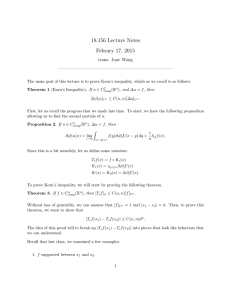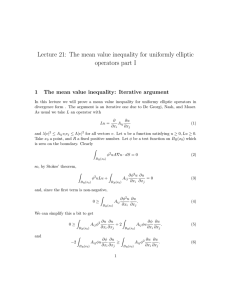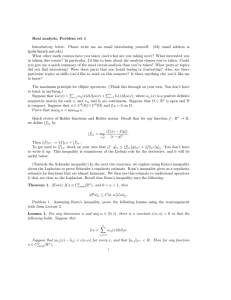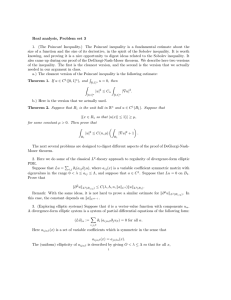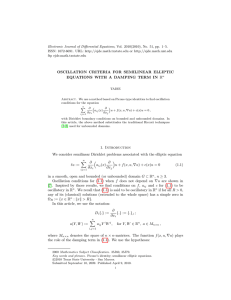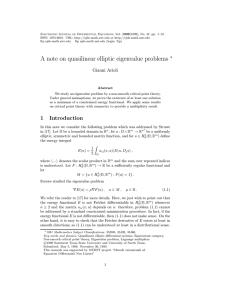Real analysis, Problem set 5
advertisement
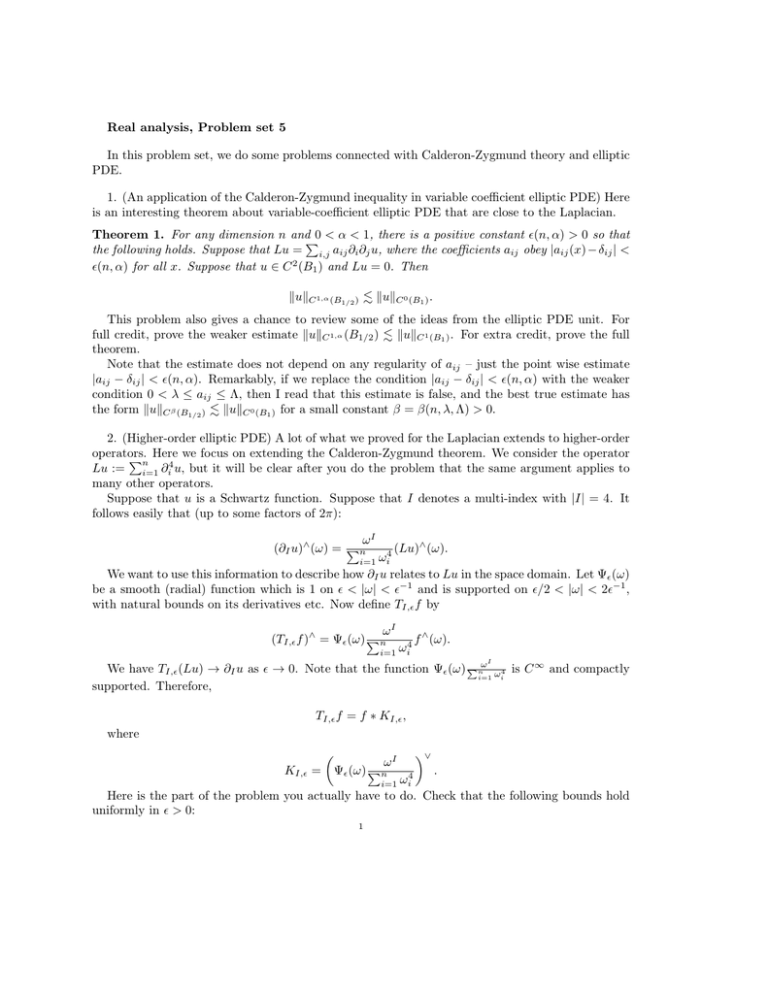
Real analysis, Problem set 5 In this problem set, we do some problems connected with Calderon-Zygmund theory and elliptic PDE. 1. (An application of the Calderon-Zygmund inequality in variable coefficient elliptic PDE) Here is an interesting theorem about variable-coefficient elliptic PDE that are close to the Laplacian. Theorem 1. For any dimension n andP0 < α < 1, there is a positive constant (n, α) > 0 so that the following holds. Suppose that Lu = i,j aij ∂i ∂j u, where the coefficients aij obey |aij (x) − δij | < (n, α) for all x. Suppose that u ∈ C 2 (B1 ) and Lu = 0. Then kukC 1,α (B1/2 ) . kukC 0 (B1 ) . This problem also gives a chance to review some of the ideas from the elliptic PDE unit. For full credit, prove the weaker estimate kukC 1,α (B1/2 ) . kukC 1 (B1 ) . For extra credit, prove the full theorem. Note that the estimate does not depend on any regularity of aij – just the point wise estimate |aij − δij | < (n, α). Remarkably, if we replace the condition |aij − δij | < (n, α) with the weaker condition 0 < λ ≤ aij ≤ Λ, then I read that this estimate is false, and the best true estimate has the form kukC β (B1/2 ) . kukC 0 (B1 ) for a small constant β = β(n, λ, Λ) > 0. 2. (Higher-order elliptic PDE) A lot of what we proved for the Laplacian extends to higher-order operators. Pn Here we focus on extending the Calderon-Zygmund theorem. We consider the operator Lu := i=1 ∂i4 u, but it will be clear after you do the problem that the same argument applies to many other operators. Suppose that u is a Schwartz function. Suppose that I denotes a multi-index with |I| = 4. It follows easily that (up to some factors of 2π): ωI (∂I u)∧ (ω) = Pn (Lu)∧ (ω). ωi4 We want to use this information to describe how ∂I u relates to Lu in the space domain. Let Ψ (ω) be a smooth (radial) function which is 1 on < |ω| < −1 and is supported on /2 < |ω| < 2−1 , with natural bounds on its derivatives etc. Now define TI, f by i=1 ωI (TI, f )∧ = Ψ (ω) Pn i=1 ωi4 f ∧ (ω). I We have TI, (Lu) → ∂I u as → 0. Note that the function Ψ (ω) Pnω ω4 is C ∞ and compactly i=1 i supported. Therefore, TI, f = f ∗ KI, , where ωI = Ψ (ω) Pn ∨ . ωi4 Here is the part of the problem you actually have to do. Check that the following bounds hold uniformly in > 0: KI, i=1 1 2 (1) |KI, (x)| . |x|−n . (2) |∂KI, (x)| . |x|−n−1 . (3) kTI, f k2 . kf k2 . Using these three properties, the Calderon-Zygmund inequality implies that for all 1 < p < ∞, uniformly in , kTI, f kp ≤ C(p, n)kf kp . Therefore, for all Schwartz u, k∂I ukp . kLukp . Optional. By a similar argument, the Korn inequality (and the Schauder inequality) extend to higher order elliptic PDE. Here we discuss the Korn inequality. To prove Korn’s inequality, we need estimates (1) and (2) above, and we also need the cancellation: for any sphere of radius r, R K = 0. For the kernels KI, above, this equation does not always hold. First figure out for Sr which choices of I the equation holds. Next, here is a way to get around this. Prove that for each I, we can choose a constant cI so that, if we define K̃I, ωI := Ψ Pn i=1 ∨ ωi4 − cI , R then Sr K̃I, = 0 for every radius r > 0. ∞ Using this observation, check that if u ∈ Ccomp (Rn ), and 0 < α < 1, then the proof of Korn’s inequality can be adapted to show that [∂ 4 u]α . [Lu]α . This problem is optional anyway, so write as little or as much as you like about this adaptation. (Recall that [g]α := supx,y |g(x)−g(y)| |x−y|α .) Final comment. You will not be surprised to learn that the part of the elliptic theory which is hardest to adapt to this higher-order setting is the boundary regularity theory, which one needs in order to set up the Dirichlet problem. In fact, it’s rather subtle to even state the right version of boundary regularity and the Dirichlet problem. I don’t know this area myself, but I believe it was worked out by Agmon, Douglis, and Nirenberg in two papers titled “Estimates near the boundary for solutions of elliptic partial differential equations satisfying general boundary conditions, parts I and II.”
![1. Let R = C[x].](http://s2.studylib.net/store/data/010491179_1-9a9c70e395518f466f652079f02ae14a-300x300.png)
